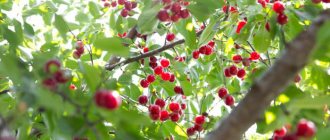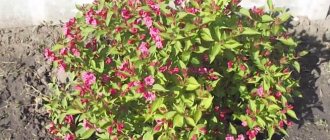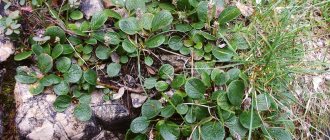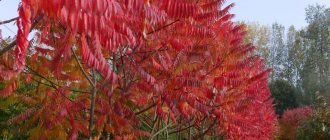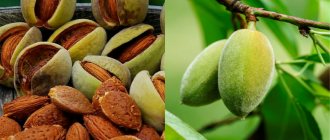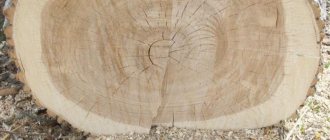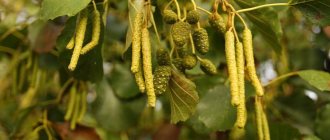09/24/2020 Scientist cat Nature
The population of most of our country believes that willow is a tree, but it is more often called willow. It is found in almost every corner of our Motherland, near reservoirs and in river valleys, along roads and in the forest. In addition, the ability to quickly and easily take root, as well as rapid growth, allow this plant to be widely used for urban landscaping. In this article we will tell you clearly and clearly about the willow plant: what kind of tree it is, its qualities and properties.
Willow is a tree or shrub, what it looks like, how it differs from willow, what it symbolizes
Download Original]” class=”imagefield imagefield-lightbox2 imagefield-lightbox2-resizeimgpost-500-500 imagefield-field_imgblogpost imagecache imagecache-field_imgblogpost imagecache-resizeimgpost-500-500 imagecache-field_imgblogpost-resizeimgpost-500-500″>
Holly willow, also known as pussy willow, is a tree or shrub with an oval-shaped crown and red bark. The name was given to the plant by the people, just like its other names: krasnotal, shelyuga, verboloz.
Willow is considered a magical and medicinal plant; people used it to protect against evil spirits and to treat diseases.
Today, the willow is a symbol of awakening nature, the beginning of spring and the good Christian holiday - Palm Sunday.
Content:
Willow belongs to the willow family. Its official name is holly willow.
It can look like a tree-like shrub or tree up to 12 meters high with thin and long twig-like branches covered with light fluff or a waxy coating.
The color of the branches can be brown-red, bright burgundy or yellowish.
The branches are directed upward, intertwined with each other and form an oval-shaped crown.
In early spring, at the end of March and beginning of April, gray-white fluffy buds appear on the branches. These are the male flowers of the plant. As they mature, they open and yellow pollen appears at the ends of the elongated stamens.
The opened flower looks like a fluffy yellow chicken. The hairs of the flower, which give it a fluffy appearance, are necessary for protection from frost, which is still common in early spring.
On some branches, fluffy buds never appear. Instead, we see long gray-green earrings. These are female flowers. They wait for pollination by male pollen to begin the process of seed maturation. The seeds fully ripen by the end of May - beginning of June.
Willow has all the characteristics of a wind-pollinated plant, but it is a honey-bearing shrub, which is necessary for early bees and bumblebees during the period when everything in nature is still dormant.
By tearing out all the flowering branches for the church holiday, people deprive insects of their only source of food, and the willow is deprived of the opportunity to sow ripened seeds. Therefore, after the holiday, the branches can be planted in moist soil.
They will definitely take root, and a new tree with fluffy lambs on the branches will appear in nature.
According to botanists, it is a shrub or a very small tree. Unlike other species of willow, which have a powerful trunk up to several meters in girth, willow branches rise directly from the ground or form into a conditionally thickened trunk, from which shoots then grow.
Whether the plant becomes a tree or remains in the form of a bush depends on the conditions of the place where it grows and the age of the plant.
In conditions suitable for it, it grows into dense thickets. This feature can be used to strengthen the soil along the banks of rivers, ravines, canals, and ditches.
It is a deciduous tree or tall shrub with dark bark and a spreading crown.
Winter willow has bare, intertwined branches of a red hue, contrasting against the background of snow and pale colored sky.
Spring awakens the holly willow first among all the plants of the Middle Zone.
Long before the foliage appears, its buds swell, which are oblong-shaped lumps with a fluffy white-yellow surface.
This flowering period is popular among photographers, in whose photographs touching blossoming branches symbolize the long-awaited spring and warmth.
In biology there is no separate name for fluffy buds.
People are accustomed to calling them “chickens” or “seals.”
The early flowering of the holly willow activates the imagination of photographers who create collages where, instead of a real blossoming bud, a kitten sits on a red branch, touchingly clasping it with its paws.
As they fade, the buds turn into earring flowers, which then produce seeds. By summer, the branches are completely free of earrings and are covered with round-shaped leaves.
Summer willow is a tree-like shrub with an oval green crown.
If you call a tree willow, then there will be no fundamental mistake in this, since it is one of the types of willow, and even has an official name - Acute willow. But the name “willow” cannot be applied to any tree of the willow species.
Four main differences between willow and other types of willows:
- Dark red color of the bark of the trunk and branches. Willow twigs are gray, yellowish.
- The shoots are easy to break, they bend poorly, grow predominantly upward, and in the bush they create a tightly intertwined crown. Willow shoots are picturesquely inclined downwards, elastic and flexible.
- Fluffy buds appear before the leaves bloom; willow buds appear simultaneously with the leaves.
- It takes root well in any conditions, and willow can only live on the shore of a reservoir.
The name of the Christian holiday - “Palm Sunday” - implies the consecration of the branches of the holly willow.
On the eve of the holiday, bunches of branches of willow trees are sold around the temples. Knowing the four differences described above will help you purchase the right plant.
Let's watch the video and learn more about the differences between willow and willow:
Unlike willow, which settles near water, willow can grow anywhere. She also loves water, but is so unpretentious that she can live in urban environments.
In conditions of high humidity, it grows quickly, forming dense thickets.
In Russia, holly willow can be found almost everywhere: in the Urals, in the European part, in Siberia, in the black soil region of the southern direction.
The plant is widespread in Ukraine. Residents of the country revere the willow as a symbol of their Motherland.
An unpretentious plant that can grow in almost any conditions. To plant a new tree yourself, you need to take a branch from an adult plant and plant it in moist soil.
Despite the fact that willow can survive in sandstones, in swamps, in fields, and in gardens, it has its own preferences.
If you provide the newly planted bush with soil with high humidity and acidity, the rooting process will be faster, and in a few years it will create thickets.
Willow is able to survive the winter in severe frosts, waking up first and notifying about the coming spring with its fluffy buds.
Urban conditions with harmful automobile exhausts, industrial emissions and other atmospheric pollution are also not an obstacle to active growth.
It began to be used in landscape design relatively recently. Having been undeservedly forgotten because of its “nationality,” it returned to parks, private and botanical gardens as a fast-growing plant that lends itself well to decoration.
The special flexibility of the trunks of the willow family, to which it belongs, makes it possible to form from them braids, twisted trunks - posts, diamond-shaped hedges.
In its original form, it points to the “Russian” direction in landscape design. It goes well with birch and spruce trees, playing off the “Russian style”.
Let's watch an interesting video about the use of wood in landscape design:
The willow was valued by the people for several reasons: it was considered a magical plant that could draw out illnesses, ward off misfortune, and also served as a medicine for healing many ailments.
Traditional medicine today uses it in the treatment of:
- sore throats, colds, inflammatory diseases, feverish conditions;
- gynecological pathologies, internal bleeding;
- varicose veins and dermatological diseases;
- diseases of the gastrointestinal tract affecting the mucous membrane.
A decoction of the bark thins the blood, disinfects wounds, and stops diarrhea and bleeding.
This is a tree with strong energy. People believed that she was able to take away diseases. To eliminate a headache, just hold a sprig of the plant in your hand.
And serious diseases will be transferred to the tree if you tie a straw belt on it, which the sick person had previously worn.
On Palm Day, they tapped household members, loved ones and livestock with bouquets of twigs, knocking diseases out of them.
For the success of the journey, it was considered necessary to eat three buds from a blessed branch before leaving home.
Infertile couples were treated by constantly carrying tree branches with them.
The branches hung over the threshold of the house were supposed to protect it from ill-wishers and thieves.
Staying near a tree for a long time is not recommended. Having selected all the negativity from a person’s energy field, it can begin to take energy, which can result in loss of strength and depression.
In ancient times, the flowering of a tree was used to predict the fertility of the coming agricultural year. The top strewn with buds promises a bountiful first harvest.
If the lower part of the crown is abundantly strewn with buds, then the last sowing will be the most fertile.
- nload Original]” class=”imagefield imagefield-lightbox2 imagefield-lightbox2-resizeimgpost-500-500 imagefield-field_imgblogpost imagecache imagecache-field_imgblogpost imagecache-resizeimgpost-500-500 imagecache-field_imgblogpost-resizeimgpost-500-500″>
- nload Original]” class=”imagefield imagefield-lightbox2 imagefield-lightbox2-resizeimgpost-500-500 imagefield-field_imgblogpost imagecache imagecache-field_imgblogpost imagecache-resizeimgpost-500-500 imagecache-field_imgblogpost-resizeimgpost-500-500″>
- nload Original]” class=”imagefield imagefield-lightbox2 imagefield-lightbox2-resizeimgpost-500-500 imagefield-field_imgblogpost imagecache imagecache-field_imgblogpost imagecache-resizeimgpost-500-500 imagecache-field_imgblogpost-resizeimgpost-500-500″>
- nload Original]” class=”imagefield imagefield-lightbox2 imagefield-lightbox2-resizeimgpost-500-500 imagefield-field_imgblogpost imagecache imagecache-field_imgblogpost imagecache-resizeimgpost-500-500 imagecache-field_imgblogpost-resizeimgpost-500-500″>
- nload Original]” class=”imagefield imagefield-lightbox2 imagefield-lightbox2-resizeimgpost-500-500 imagefield-field_imgblogpost imagecache imagecache-field_imgblogpost imagecache-resizeimgpost-500-500 imagecache-field_imgblogpost-resizeimgpost-500-500″>
- nload Original]” class=”imagefield imagefield-lightbox2 imagefield-lightbox2-resizeimgpost-500-500 imagefield-field_imgblogpost imagecache imagecache-field_imgblogpost imagecache-resizeimgpost-500-500 imagecache-field_imgblogpost-resizeimgpost-500-500″>
- nload Original]” class=”imagefield imagefield-lightbox2 imagefield-lightbox2-resizeimgpost-500-500 imagefield-field_imgblogpost imagecache imagecache-field_imgblogpost imagecache-resizeimgpost-500-500 imagecache-field_imgblogpost-resizeimgpost-500-500″>
- nload Original]” class=”imagefield imagefield-lightbox2 imagefield-lightbox2-resizeimgpost-500-500 imagefield-field_imgblogpost imagecache imagecache-field_imgblogpost imagecache-resizeimgpost-500-500 imagecache-field_imgblogpost-resizeimgpost-500-500″>
- nload Original]” class=”imagefield imagefield-lightbox2 imagefield-lightbox2-resizeimgpost-500-500 imagefield-field_imgblogpost imagecache imagecache-field_imgblogpost imagecache-resizeimgpost-500-500 imagecache-field_imgblogpost-resizeimgpost-500-500″>
- nload Original]” class=”imagefield imagefield-lightbox2 imagefield-lightbox2-resizeimgpost-500-500 imagefield-field_imgblogpost imagecache imagecache-field_imgblogpost imagecache-resizeimgpost-500-500 imagecache-field_imgblogpost-resizeimgpost-500-500″>
A little about the meaning of willow
The tradition of bringing several branches of willow into the house in the spring has ancient sacred meaning. Our ancestors, who lived in ancient times in Rus', believed that twigs were able to drive away evil spirits from the house and bring joy, happiness and prosperity to the home. In addition, many signs are associated with the willow: for example, in the old days, people could use these branches to determine what kind of summer it would be and find out the weather.
Willow was also used for medicinal purposes and medicinal potions were prepared from it. All these, as well as many other useful qualities, made the willow so revered and, one might say, a symbolic plant in our country.
In addition, the tree also has ancient religious significance: it is believed that it was with willow branches that the Jews greeted Jesus Christ when he entered Jerusalem. Therefore, for believers, the importance of the willow is difficult to overestimate. Well, for people far from religion, the willow is valuable, first of all, for its decorativeness, freshness, and as a symbol of spring.
Modern scientific research has revealed a rich content of salicylic acid in willow, which makes it possible to rightfully consider the plant medicinal. In addition, willow is a wonderful honey plant. The plant can also be used to build a picturesque hedge, decorate a water area, and for other design and landscape purposes. But you can see what ornamental cabbage looks like in landscape design in the photo.
The video shows how to plant a willow from a twig:
Stains of willow white bark
White willow bark, rich in tannins, glucose, flavonoids, ascorbic acid and resins, has been widely used in folk medicine.
Willow bark has an antiseptic, anti-inflammatory, antipyretic and analgesic effect. Infusions of white willow measles are effective against colitis, gout, women's illnesses, gastritis, internal bleeding, diseases of the liver, spleen and other illnesses. Use the leaves of the tree to stiffen for severe bleeding in the intestines and for colds. Vaginal women and one-year-old mothers are not recommended to take medications that contain cerebrospinal fluid. The straightened willow roots are used to improve fluffy soils and sands. Willow plantations can often be found along the river streams. Vicorist wood to secure river banks, canals, slopes, slopes and edges.
From the thick willow twigs, cut folds for sheep, pens for thinness. The bark and gilk are cured like natural barnberries, which are used to prepare the skin and seam in red, brown and yellow colors.
The pulp and pliable wood quickly rots and is twisted for the preparation of germs. Gilks are used as food for thin animals, especially for goats and sheep. The bark is cured for tanning hides. In the Orthodox Verbna week, there is a long-standing tradition of using the branches of a young vikory tree to replace palm leaves.
With willow bark, go to the warehouse of various cosmetic preparations, smooth out wrinkles and remove dirt, cleanse the skin.
Previously, willow twigs and bark trees were used to make wicker dishes, furniture, cats and other products.
White willow is often used in landscape design. Visits near parks and forest parks. The rapid growth of the tree allows it to be planted for planting roads and for vigorous landscaping.
White willow bark is cured for tanning hides. Pagoni serve as food for thinness. In addition, the willow is considered a valuable honey plant. Take nectar from the bjoli tree and file the bjolin glue. During crystallization, white willow honey becomes fine-grained, has a creamy tint, and has a pleasant relish and fragrant aroma.
Varieties of willow
According to the latest data, the willow genus has 553 subspecies. We list the most famous types:
- White willow;
- Brittle;
- Basket ;
- Almond leaf;
- Willow shelyuga;
- Roman subspecies;
- Subspecies shaggy;
Willow is common in both Russia and Europe. The range is wide and can be found in such regions as:
- West Siberia
- Caucasus
- middle Asia
- Floodplains
Botanical features
Understanding the question of whether a willow is a tree or a shrub, let's look at the characteristics of the plants that we call willows. All willows, as well as other representatives of willows, have a long root system that can grow to a depth of 15 meters. People use this feature by planting a variety of willows along river banks, thereby strengthening the coastline and preventing soil erosion. Young willow plants actually look more like shrubs than trees. But over time, growing, the thin sprout turns into a large tree, the trunk diameter of which can reach 1.5 m and which is covered with gray, highly cracked bark. The shade of the bark depends on age. So, a young willow is a tree with a light gray trunk, but an older plant will have a dark color.
The spreading crown of this tree consists of drooping, thin and flexible branches, the length of which can exceed 2 m. Its young branches are hanging, thin, with delicate silver fluff at the tips. Old shoots are more bare and colored reddish-brown or yellow-brownish. On the branches there are alternate lanceolate silky and silvery leaves, the length of which can reach 12–15 cm. In the spring, simultaneously with the development of the leaves, flower earrings, consisting of very small flowers, open. The willow fades in April, and by May the fruits ripen - small bivalve capsules with small seeds covered with hairs.
Selecting a location
For willow, it is very important to choose a suitable site, since the tree is quite demanding in terms of external conditions. It is important that the place is not too sunny: the modest willow prefers shady areas. This also has its advantage, since willows can occupy spaces in the garden that are not in demand by other light-loving plants.
It is best to place the plant near a pond, and in its absence, in a lowland. Willow needs moisture, and it will not have anything against the close occurrence of groundwater, unlike most other garden crops. You can even plant a twig near a cesspool or compost pit - there will be both the moisture the plant needs and, at the same time, nutrition. However, no matter where you place the branch, in any case it will need regular, frequent watering: this must be remembered. Of course, except when it rains frequently.
On the video there is information about willow:
Willow is undemanding in terms of soil composition: the level of soil fertility is not important for this plant, but it is important that the soil is acidic.
Folk signs
The ancient Slavic tribes, who did not care at all whether the willow was a tree or a shrub, dedicated it to one of the supreme gods - Perun and called it the “Perun vine”. A plant associated with such a powerful creature was endowed with mystical and magical properties. Many household items were made from this wood. Small children were bathed in willow infusion. Willow branches in the house prevented the machinations of dark forces against the owners, and when stuck in the ceiling they protected them from being struck by lightning. To obtain a bountiful harvest, it was customary to scatter the buds of this tree over the beds; they also stuck individual branches into the field to protect the crops from inclement weather and ward off rodents. In the spring, when cattle were driven out into the field for the first time after winter, they used willow branches to protect the animals from disease, help them grow and produce healthy offspring. There was also a place in the barn for this plant, which, according to legend, could protect cattle from diseases. With the adoption of Christianity, some of the pagan rites and rituals passed into the new religion. Due to the absence of palm trees in our climate, one of the main Christian holidays (the Entry of the Lord into Jerusalem) acquired a new symbol - willow branches with blossoming buds.
Recommendations for cultivation
Although church rules recommend burning willow branches immediately after the end of the holiday, few people already follow these precepts. By the way, it is believed that it is forbidden to plant branches from a willow consecrated in a church: for religious citizens, this fact can become an obstacle to growing a tree.
However, for most people, religion does not play a big role now, so it is quite acceptable for them to try to grow a beautiful willow on their plot. After all, with proper planting and proper care, the branch will definitely take root, and in a few years it will grow into a lush, spreading bush. Let's look at the main points on how to properly grow willow from a twig.
So, experienced gardeners strongly recommend planting a twig, even if it has already successfully taken root, not immediately in open ground, but first in a pot. This way, at home, the bush will get a little stronger: the main condition for this is abundant watering. But which irrigation hose to choose, and how to do it correctly, is described here in the article.
The twig should spend a year in the pot, after which next spring it can be planted in open ground. Such slowness practically guarantees that the branch will definitely be planted in the ground in the open air. If, living in a warm climate, you decide to plant a branch directly in open ground, it is important to choose a damp place for the plant.
This could be an area near a pond or another body of water: willow needs a lot of water. In this case, there is even a chance to grow a full-fledged tree, and not a bush, as is usually the case.
Planting in open ground is not too difficult: you need to dig a branch with roots into the ground: this should be done carefully so as not to touch the roots. After the branch is in the ground, it must be covered on top with a plastic bottle with the top cut off. This measure will help protect the twig from damage by rodents, and will also protect against recurrent frosts.
Description of the white weeping willow tree and photo
Weeping willow is a leafy tree, with an open, translucent crown of curls up to 25 m. thick Stovbur, sir bark. The crown is narrow, columnar, later than the crown, wide, round.
The leaves are thin, stringy, with matte, purple and light green bark, straight uphill, the barrels hang down. Leaves are petiolate, spread across. The leaf blade is wide, eliptical, and in some species it is vuzka and dovga.
The leaf color is dark green, the lower part is light green and black. Nirki can be dark brown or red-yellow. The flowers are separate, different, non-displayable, collected in earrings. The flowering of willows occurs in early spring, before the leaves emerge.
Plaid – box. This kind of wood, with white fluff, is easy to transport by winds to distant places. Willow tree. Photo
The weeping willow tree is wider in Northern America, the tropics, and Northern America. Dwarf willows grow in the mountains. Such types of willows as willow, pussy willow, shelyuga, rokita and others are found in the European part of Russia. Teacup species grow in Siberia and Central Asia.
Ancient and other beliefs
- The ancient Slavs called the willow the perun vine.
- Children used to be bathed for health in a decoction of willow branches.
- A real ancient Slavic rite - a wedding around a willow tree.
- In the old days, Lithuanian peasant women prayed to the willow tree so that it would help them - give them a child.
- Also in ancient times, it was believed that willow helps with eloquence. In this regard, it was called the tree of poets and singers.
- In China, willow is a symbol of spring and feminine beauty, suppleness and softness.
- And Jews in ancient times called the willow a symbol of misfortune, sadness, sadness, death, funerals (namely the weeping willow).
- In Japan, this plant also carries sadness and weakness. However, it brings tenderness, grace, calmness, and constancy.
Willow (krasnotal) - Palm Sunday tree. This is a Christian spring holiday commemorating the entry of Christ into Jerusalem. The Jews greeted him with vayas - branches of the Jerusalem willow - or branches of a date palm.
How do they bloom?
Perhaps flowering is one of the main differences between willow and willow. Not only is it different, but it also occurs at different times. The willow is the first to dawn - very fluffy, slightly elongated snow-white buds open on the shoots. The willow blooms after it and the flower buds on the branches are a little longer and smaller, but just as fluffy. But the color of the inflorescences is radically different - they are a beautiful soft yellow color.
Willow blooms in mid-spring, when there are already leaves on the branches, but willow blooms very early, before the leaves bloom on the tree.
Characteristic differences between willow and willow - video
Holly willow, also known as pussy willow, is a tree or shrub with an oval-shaped crown and red bark. The name was given to the plant by the people, just like its other names: krasnotal, shelyuga, verboloz.
Willow is considered a magical and medicinal plant; people used it to protect against evil spirits and to treat diseases.
Today, the willow is a symbol of awakening nature, the beginning of spring and the good Christian holiday - Palm Sunday.
Willow in landscape design
Highly decorative at any time of the year, willow in the garden simply cannot remain out of the spotlight. Flexible branches, the ability to easily take the desired shape and unpretentious nature make this plant an ideal material for realizing design ideas. The willow tree is used to form hedges, decorate gazebos and make garden sculptures.
- willow is the central figure in the garden;
- proper trimming will help create beautiful shapes;
- willow will decorate the pond;
- a willow gazebo will become the central composition in the garden.
History of the tree. The magical power of the willow
This beautiful, golden, fine tree has been valued since ancient times.
In Ancient Greece, the willow was a symbol of the goddesses Hecate and Geri. Roman poets depicted this tree in their works. In Ancient Egypt, it was revered as a symbol of the power and wisdom of the deceased, and their nails were spat on funeral treasures. In Ancient Rome they first began to grow willow twigs. In the Middle Century, decoctions and infusions of measles, leaves and willow leaves were distilled to soothe wounds and bleeding spots.
The weeping willow tree has long been revered by women and dedicated to the monthly goddesses, the month and birth. They were endowed with magical powers. Slavic pagans used twigs from this tree to decorate their furniture before performing rituals. Wires and weaving from willow twigs were known as love spells. A mixture of willow leaves was mixed into the cow’s drink, which served as a love spell. Amulets for success in love affairs were made from trees. Such embellishment was worn by unfortunate people. Among the Slovenians, the willow was called willow, willow and rokita. This is what we call vikoryists and now.
Today, the willow is considered a calm tree. Contact with it has a beneficial effect on the nervous system, puts thoughts in order, relieves headaches and improves mood.
This tree is associated with folk signs and superstitions. It is important that if you tap on a willow tree, it will bring you good luck. If you put these leaves under your pillow, you will have a sweet dream.
Due to its nature, the willow is sensitive, and those who interact with it need to be extremely sensitive, especially not to like the willow of liars, which can cause a negative impact on the health and fate of the poor people.
Healing properties of the plant
The willow was valued by the people for several reasons: it was considered a magical plant that could draw out illnesses, ward off misfortune, and also served as a medicine for healing many ailments.
Traditional medicine today uses it in the treatment of:
- sore throats, colds, inflammatory diseases, feverish conditions;
- gynecological pathologies, internal bleeding;
- varicose veins and dermatological diseases;
- diseases of the gastrointestinal tract affecting the mucous membrane.
A decoction of the bark thins the blood, disinfects wounds, and stops diarrhea and bleeding.
Description of willow
There are about 170 varieties of wood.
The most common species that can be found in the cities of Russia, Iraq, Iran and in European countries is the white willow. Since this tree loves moisture, it can be found in areas of rivers, lakes and reservoirs, but can also be found in parks, alleys, and along roads. Willow not only serves for greening the environment, but also serves for the production of furniture, baskets, and textiles. Willow branches provide food for domestic animals such as goats and sheep. Willow is a valuable tree for beekeepers, as it is a good honey plant . And also in Russia, this tree or bush is considered a symbol of the Orthodox holiday “Palm Sunday”. This plant is also popular in medicine.
There are several subspecies of willow, and they differ slightly from each other. The leaves on one species may be green, slightly curled, and densely spaced on the branches, while on other species they may be light green and sparsely spaced on the branches. The leaves may also be gray-white. The leaf shape is elliptical, narrow, oblong. The edges of the leaves are entire. The branches are thin, twig-like in appearance, bend well, and are covered with shiny bark, mostly green.
Buds on willow can be either burgundy or dark yellow. In early spring, before the leaves open, the willow begins to bloom, but there are subspecies that bloom in the first months of summer, while the leaves appear. The flowers are not particularly noticeable in appearance. Their size is small, but if they are collected in a bun or as earrings are called, then you can notice them.
How to select and save
If you decide to buy already cut willow branches, take the time to inspect the “product” before paying. The cut should be light, fresh and fragrant, the bud stalk should not be too dry. Choose willow branches on the buds of which yellow-green flowers have not yet appeared - such a branch will be older than the one whose buds have not yet bloomed and still resemble a gray-white fluffy lump.
At home, place the willow in an empty vase, without water, so the branches can stand until next Palm Sunday. Branches need to be placed in water only if you plan, for example, to plant a tree: in the water, the willow will eventually develop leaves and roots, and the shoot can be transplanted to open ground.
If you want to preserve the willow (for example, consecrated) for the next year, you need to keep the branches in a cool, shaded place; direct sunlight and temperatures above 10 degrees Celsius are contraindicated.
Viroschuvannya willow
In households, willows are propagated live.
The live baits, cut before the logs are released, quickly take root. Before the roots are established, they can be placed in water, and then planted in the ground. Due to the fact that the willow is not vigorous and takes root in the shortest possible time, its live bait is built in greenhouses near the ground, so that 2-3 branches are lost on the surface of the soil. Propagate willow with green live bait. To do this, make an oblique cut at the bottom, remove the top soil and shorten the leaf plates. Then the live bait is placed in a greenhouse or under a jar.
When planting willow bushes, dig small pits 50x50 cm for skin planting. The soil should be filled with soil mixture, which consists of soil, compost, peat and manure. Mineral supplements are added. The growth does not sag up to the ground, but it gives the advantage of light and medium loam. It is better to carry out the sensing of willow in a well-lit, sleepy place. Trees cannot grow in the shade. Special care for willow is required during the first year of planting.
Young seedlings will require constant watering and fertilization. During the dry period, water them once a week (20-50 liters of water per skin growth). In the spring, the soil is fluffed up and mulched. Dry leaves are trimmed and a crown is formed. Long chases on the lower part of the stovbur can be seen.
Sources used:
- https://ogorodsadovod.com/entry/3847-verba-eto-derevo-ili-kustarnik-kak-vyglyadit-chem-otlichaetsya-ot-ivy-chto-simvoliziruet
- https://decor-garden.com.ua/derevo/iva-plakuchaya.php.htm
- https://fb.ru/article/186642/verba-derevo-opisanie-verba—eto-derevo-ili-kustarnik
- https://moysadiogorod.ru/kak-vygljadit-verba-derevo
- https://fikus.guru/derevya/verba-opisanie-raznovidnosti-ivy-primenenie-i-lechebnye-svoystva.html
Recommended news
“Moscow Model” will be closed for reconstruction on October 1
An official accused of insulting the residents of Tulun was removed from office
You can visit 80 capital museums for free on City Day
Where to go for City Day? The Flower Jam festival takes place in Moscow.
Looking for the perfect beach getaway? Choose Phuket!
Russians spoke about their attitude to alcohol at corporate events
Warm summer weather expected in the capital on September 3
A ranking of countries from which foreigners most often come to Russia has been published
Moskalkova spoke about the progress of the dialogue with Kiev on the exchange of detainees
The history of the tin can: how the most reliable packaging appeared
Roza Syabitova assessed Natalia Poklonskaya's chances of getting married again
Scientists: A healthy diet can reduce the risk of eye diseases
Elena Proklova shared the secret of beauty and health
In total, there are about 600 species of willow in the world.
Read also: Why the goat reduced milk reasons
Natalya Feoktistova, “Evening Moscow”
But the holiday is real, and therefore you don’t want to be deceived on this day even in small things. Therefore, we decided to tell you how to distinguish willow from willow, which is often passed off as it.
Willow is also called krasnotal and shelyuga, as well as verbolosis. Willow is a deciduous plant (shrub or tree). Its types differ from each other mainly in external characteristics. In total, there are about 600 species of plants of this genus in the world. So, let’s talk about the main mistake right away: no, willow and willow are not at all the same plant under two different names. These plants are different, and willow and willow, despite the fact that they are relatives, differ in at least four characteristics, which are very easy to remember. So, both plants, undoubtedly belonging to the common willow family, can be distinguished:
* externally - by the color of flower buds and bark;
* according to place of growth;
* according to characteristics and flowering time.
Some signs, however, are useful only to those who decide to go for the willow on their own. Previously, by the way, no one would have even thought that it was necessary to buy willow - they went for it themselves, with their own feet, since the ritual of “breaking” willows was organically included in the ritual part of the holiday.
So, where can you find willow? The answer will surprise you: everywhere. She is unpretentious to the point of envy. She is satisfied with everything - “pure fields” and river banks, swamps, the outskirts of forests and villages. Absolutely not a picky creature! But the main thing is that its branches form a fairly dense crown of relatively thick shoots of a red-brown color. Willow branches bend poorly and produce rounded leaves.
The willow crown is different. It is transparent, lacy, the shoots of the willow droop and go down, which looks very picturesque. And willow grows mainly near ponds and rivers. When the willow leaves bloom, you can immediately see that they are elongated, long, with a pointed tip. Willow branches are very flexible, ideal for weaving, and if you put them in water, they grow roots very quickly. Moreover: if you simply stick a willow twig into the ground without waiting for the roots, it will most likely also take root, and will soon fill the entire surrounding space. Willow bark is light, gray, sometimes greenish, sometimes almost golden.
The willow does not have such a high ability to take root. It can put down roots, but it is unlikely to simply take root in the ground.
In addition, the plants differ in their flowering. The willow blooms first. The branches of all the trees are still bare, and on its dense branches snow-white buds are already opening, sometimes with a pearly or slightly grayish tint. Willow blooms later, its flower buds are smaller and not as expressive, although they are also fluffy. But the main difference is that they, unlike willows, have a golden-olive or golden-yellow color. So, once again, the main thing: willow blooms in a leafless state, willow - when the tree is already covered with leaves.
The willow blooms first. The branches of all the trees are still bare, and on its dense branches snow-white buds are already opening, sometimes with a pearly or slightly grayish tint.
PHOTO: Anton Gerdo, “Evening Moscow”
If you choose a willow at the market, first look at the color of its bark: take one that is red or brown, with a slight waxy coating on the bark. Not very honest sellers may offer you willow, but you can easily distinguish it by its “dormant” buds, by the color of its bark, and by its flexibility.
What to do if you bought the wrong branches? It's simple: forgive the cunning people. It’s unlikely that they charged you a lot for a modest bouquet. Well, forgive the deceivers for this deception from the bottom of your heart - God is with them, because in forgiveness there is grace. In addition, perhaps it was an involuntary deception - not many people understand all these botanical subtleties. But buy real willow, don’t worry.
Willow family
Each one is beautiful in its own way, and the willow and willow are somewhat similar. There is still a difference between them.
Willow is a deciduous plant (shrub or tree). Its types differ from each other mainly in external characteristics. In general, there are about 600 species of plants of this genus in the world.
The entire willow family in Russia has more than 120 species: chernotal, broom, belotal, molokita, willow, shelyuga, goat willow and many others.
This plant has an unimaginable desire for life: any shoot, twig or stump stuck into the ground is quickly covered with numerous young shoots.
How to distinguish willow from willow? When talking about these two plants, many people think that we are talking about one plant, but this is not so. They belong to the same genus (family) - willows. They have differences.
Some species of plants from the willow genus are called willow. For example: holly willow, goat willow, wolf willow, etc.
Willow - a Christian symbol and healer
Willow is a common inhabitant of Russian soil and a sacred tree of Christians. It has long become a symbol of spring and the holiday of Palm Sunday. The tree means the approach of Easter.
Ancient ancestors endowed willow with magical properties and pinned their hopes and prayers on it. They believed that it gave health. The willow tree was asked to pacify fire and storm, give a child and endow it with eloquence. For the first time in the year, the cattle were driven out to pasture after being blessed with willow. Willow branches protected the house from lightning and protected the crops from rodents. Bath brooms were knitted from twigs and babies were bathed in a decoction of the shoots. Willow is actively used in folk medicine.
Willow
The pussy willow (Salix) in the photo belongs to the willow family. It is also called willow, willow, weeping or goat willow, molokita, belotal. It has extraordinary vitality and quickly takes root. Willow is not at all picky about the soil and place of growth. It is found in ravines, fields, along roads and along the banks of reservoirs. The dense crown of a tall tree (25-30 m) is formed by strong red-brown branches with little flexibility. The young plant is a shrub. The shoots are covered with rounded leaves. White willow blooms in early spring with snow-white, oblong buds with pubescence.
history of the holiday
Palm Sunday is one of the most important holidays for Christians. It is considered a symbol of the recognition of Jesus as the Messiah. Willow branches became an attribute of the holiday, which are consecrated during worship, and then decorated with icons and windows of one’s home.
The holiday is associated with the solemn entry of Jesus Christ into Jerusalem. This happened shortly after the famous resurrection of Lazarus from Bethany. The news of this event quickly spread throughout the nearby villages. Jesus appeared in the city on a donkey, as a messenger of peace, along with a retinue of apostles. The Jewish people recognized Christ as the Messiah who came to deliver them from slavery, sin and death. The entire path of Christ was strewn with palm branches and flowers, and residents laid clothes at his feet.
Palm Sunday
In memory of this event, palm branches are consecrated in Orthodox churches on Palm Sunday, which symbolize those with which Christ was greeted. For the Slavic peoples they were replaced by the white willow, which grows in their climate. She is the first to bloom and give shoots. The holiday was named after the willow branches used in worship.
Traditions and rituals of the holiday
On Palm Sunday, festive services are held in Orthodox cathedrals with the blessing of palm branches.
The celebration begins the evening before, when believers come to church for an all-night vigil. During the service, the priest reads Psalm 50 and the Gospel. Parishioners hold candles and willow branches until the end of the service, when the willow is sprinkled with holy water. The consecration of the willow also takes place on Sunday, during the Liturgy of St. John Chrysostom.
On the eve of the holiday you need to prepare twigs. You need white willow trees where there are no broken or withered branches, hollows or damage to the trunk. Branches are cut from young trees. It is not recommended to use trees near water bodies and cemeteries for harvesting. According to legends, there may be evil spirits on them.
Traditionally, families whip children and adults with branches with the sentence: “I don’t hit, it’s the willow that hits!” Performing a ritual can protect against the evil eye and evil spirits. Newlyweds and young girls were also whipped with willow sprinkled for the holiday so that they would give birth to more healthy children.
Blessed branches are placed in the corner near the icons and stored until the next holiday, believing that they will protect against misfortunes. Then they are burned or thrown into a pond, but in no case are they thrown out or trampled underfoot.
Willow branches
On this holiday, traditional healers go to harvest willow buds. It is believed that the prepared infusions help preserve male strength and conceive a child in women. Housewives store willow buds to add to pies. Such baked goods will protect household members from various diseases.
Girls practice love spells on future betrotheds. For this purpose they use gypsy magic. You need to break several branches from the willow and tie them with red thread. At the same time, they make a wish for the groom and store the bunch under the images. It is forbidden to throw away the bundle, because this way you can ruin your life and the young man.
In some areas there is a long-standing tradition of holding fairs and bazaars on Sunday. They organize festivities with entertainment for children and adults, and unusual treats. Folk craftsmen also participate. They sell handicraft goods and cherubs, which are willow branches decorated with angel figures.
Palm Sunday is celebrated on April 1 in 2021.
Signs and beliefs
The holiday is endowed with a mystical aura. On this day, they predicted the harvest, performed rituals for healing, attracting good luck and prosperity. Here are some of them:
- Planting or replanting an indoor flower on Palm Sunday will bring prosperity and prosperity to your home. If it is well received and grows, then you should expect profit. If it fades, prepare for losses.
- Good weather on Palm Sunday foretells a high fruit harvest.
- Before starting an important task, you should eat three willow buds from the branches brought from the temple on this holiday. And they will help attract good luck.
- This ritual will help to get rid of headaches. You need to comb your hair thoroughly and collect it from the comb. Then put it in water and pour everything under the willow root.
- The white willow will help single girls who dream of getting married next year.
You should go to a young tree before dawn and break branches. Place them at the head of your bed and think about your lover throughout the day. White willow
Medicinal properties
Young shoots of willow and bark are endowed with medicinal properties. The bark contains tannins, pectins, flavonoids, ascorbic acid and vitamins, glycosides, trace elements and salicin, which acts as an antibiotic.
Willow has an analgesic and anti-inflammatory effect, relieves fever and calms the nerves. Effectively stops bleeding. It is a good diuretic and choleretic agent. Disinfects wounds and accelerates their healing.
Traditional medicine recommends white willow in the following cases:
- For colds and headaches
- As an expectorant for coughs
- For the treatment of gout, osteochondrosis and rheumatism
- For diarrhea, dysentery, jaundice and malaria
- In case of arrhythmia and inflammation in the oral cavity
- For inflammatory diseases of the digestive system and bladder
- For the treatment of varicose veins and combating sweating of the extremities
- Used externally for ulcers and eczema
Bark is removed from trees older than 6 years in early spring. Plates 1-4 mm thick are crushed and dried in the sun until they become brittle.
Bark
Folk recipes
To treat each ailment, a different scheme and recipe for preparing a potion is used.
- For gastritis, enterocolitis and all gastrointestinal diseases, drink 1 tbsp of the decoction. before meals 4 times a day. This is how they prepare it. Pour a glass of water into a tablespoon of dry, crushed bark. Let it boil and simmer for 30 minutes over low heat. Strain after cooling.
- Rheumatism and joint diseases are treated with a decoction of willow bark in a steam bath. It is prepared from a spoon of raw materials and a glass of water, which are boiled for 30 minutes. Dosage regimen: 1 tablespoon 4-5 times a day before meals.
- The following decoction will help get rid of diarrhea. take 400 ml of water and pour 1 tbsp. l bark powder. Boil the mixture for 25 minutes. Strain and add boiled water to restore volume. Take 2 tablespoons 3 times a day.
- Baths are given for sweating feet and hands. The composition is prepared from 1 teaspoon of white willow bark and 2 glasses of cold water. It is infused for 8 hours. The duration of the procedure is 15 minutes.
- Willow bark helps with varicose veins, fungal skin diseases, ulcers, boils and erysipelas. To do this, prepare baths from a glass of crushed raw materials, poured boiling water and infused for half an hour. The infusion is poured into a basin and topped up with hot water to the required volume.
- To calm the nervous system and overcome stress, prepare a drink from 1 tbsp. willow bark and 0.4 liters of boiling water. The infusion is kept for several hours and taken 1 sip throughout the day.
- Dry willow bark powder is used to cover wounds.
- Young branches are soaked and applied to the forehead for headaches.
- Fluffy willow buds, if carried in a linen bag in the area of the heart, stabilize heart rate and blood pressure.
Preparing the decoction
The use of willow in cosmetology
The beneficial properties of willow are actively used in home cosmetology.
Juice from willow bark helps relieve inflammation and redness on the skin and eliminate fine wrinkles. Fresh white willow bark is crushed, soaked in a napkin and applied to the face for 10-15 minutes. A decoction for rinsing hair is prepared from a decoction of willow bark and burdock rhizome. It helps strengthen hair, remove dandruff and itching.
Willow is also used to remove warts. The ash is used after burning several branches. The powder is mixed with vinegar until it becomes pasty and applied to the warts until they disappear.
Magic properties
The positive energy of the willow tree has a beneficial effect on the human body. Contact with willow calms the nervous system and relaxes, headaches go away.
Our ancestors endowed tree branches with magical properties. After consecration on Palm Sunday, they were kept in the house as a talisman capable of protecting the house and family members from misfortunes and illnesses, evil spirits and unkind people.
Amulet
Contraindications
Willow also has contraindications. It is prohibited to treat with willow children under 16 years of age, pregnant and lactating women, and persons with individual intolerance.
It should not be taken if you have stomach and intestinal ulcers or high stomach acidity. Treatment with willow is contraindicated in combination with taking aspirin, antacids, cold medications, synthetic vitamins, and laxatives.
Watch also the video on the topic:
Similar articles
rasteniyadom.ru
